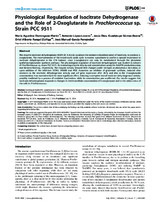Physiological Regulation of Isocitrate Dehydrogenase and the Role of 2-Oxoglutarate in Prochlorococcus sp. Strain PCC 9511
Autor
Domínguez-Martín, María A.
López-Lozano, Antonio
Díez Dapena, Jesús
Gómez-Baena, Guadalupe
Rangel Zúñiga, Oriol Alberto
García-Fernández, José Manuel
Editor
Public Library of ScienceFecha
2014Materia
CyanobacteriaSynechocystis
Enzyme regulation
Enzymes
Vitamin C
Enzyme metabolism
Dehydrogenases
Metabolic pathways
METS:
Mostrar el registro METSPREMIS:
Mostrar el registro PREMISMetadatos
Mostrar el registro completo del ítemResumen
The enzyme isocitrate dehydrogenase (ICDH; EC 1.1.1.42) catalyzes the oxidative decarboxylation of isocitrate, to produce 2-
oxoglutarate. The incompleteness of the tricarboxylic acids cycle in marine cyanobacteria confers a special importance to
isocitrate dehydrogenase in the C/N balance, since 2-oxoglutarate can only be metabolized through the glutamine
synthetase/glutamate synthase pathway. The physiological regulation of isocitrate dehydrogenase was studied in cultures
of Prochlorococcus sp. strain PCC 9511, by measuring enzyme activity and concentration using the NADPH production assay
and Western blotting, respectively. The enzyme activity showed little changes under nitrogen or phosphorus starvation, or
upon addition of the inhibitors DCMU, DBMIB and MSX. Azaserine, an inhibitor of glutamate synthase, induced clear
increases in the isocitrate dehydrogenase activity and icd gene expression after 24 h, and also in the 2-oxoglutarate
concentration. Iron starvation had the most significant effect, inducing a complete loss of isocitrate dehydrogenase activity,
possibly mediated by a process of oxidative inactivation, while its concentration was unaffected. Our results suggest that
isocitrate dehydrogenase responds to changes in the intracellular concentration of 2-oxoglutarate and to the redox status of
the cells in Prochlorococcus.

